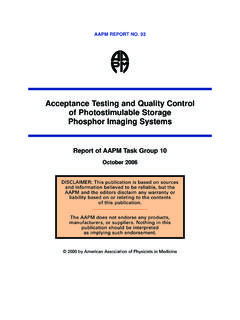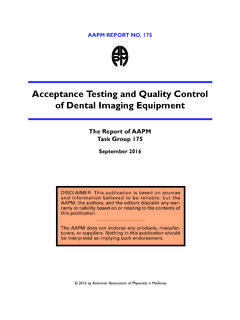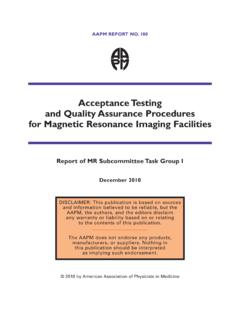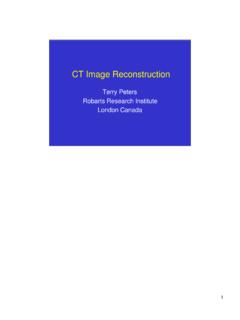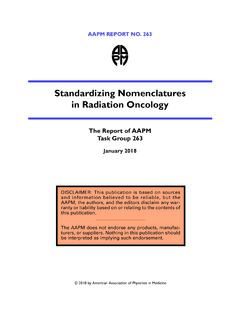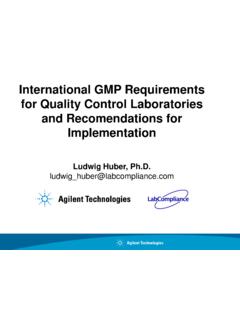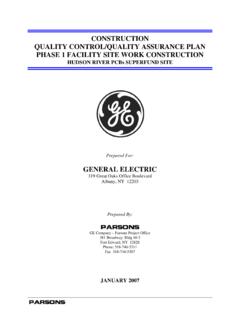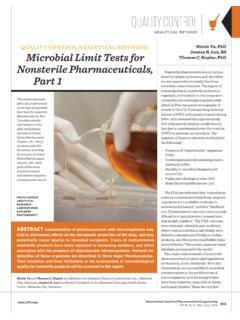Transcription of PET/CT Acceptance Testing and Quality Assurance
1 AAPM REPORT NO. 126 PET/CT Acceptance Testingand Quality AssuranceThe Report of AAPMTask Group 126 October 2019 DISCLAIMER: This publication is based on sourcesand information believed to be reliable, but theAAPM, the authors, and the editors disclaim any war-ranty or liability based on or relating to the contents ofthis AAPM does not endorse any products, manufac-turers, or suppliers. Nothing in this publication shouldbe interpreted as implying such endorsement. 2019 by American Association of Physicists in MedicineThis page intentionally left Acceptance Testingand Quality AssuranceThe Report of AAPM Task Group 126 Osama R. Mawlawi, (Chair)1, Brad J.
2 Kemp, ,David W. Jordan, , Janice M. Campbell, ,James R. Halama, , Richard J. Massoth, ,Charles R. Schmidtlein, , Jon D. Shepard, ,Wesley W. Wooten, , and Jon A. Anderson, of Texas MD Anderson Cancer Center, Houston, TX2 Mayo Clinic, Rochester, MN3 University Hospitals Cleveland Medical Center, Cleveland, OH4 William Beaumont Hospital, Royal Oak, MI5 Loyola University Medical Center, Maywood, IL6 Sunflower Medical Physics, LLC, Shawnee, KS7 Memorial Sloan Kettering Cancer Center, New York, NY8 Fusion Physics, LLC, Valrico, FL9 Medical Imaging Physics, Orinda, CA10 University of Texas Southwestern Medical Center, Dallas, TXDISCLAIMER.
3 This publication is based on sources and information believed to be reliable,but the AAPM, the authors, and the publisher disclaim any warranty or liabilitybased on or relating to the contents of this AAPM does not endorse any products, manufacturers, or suppliers. Nothing in thispublication should be interpreted as implying such : 978-1-936366-73-6 ISSN: 0271-7344 2019 by American Association of Physicists in MedicineAll rights reservedPublished byAmerican Association of Physicists in Medicine1631 Prince StreetAlexandria, VA 22314 AcknowledgmentsThis report summarizes the recommendations of the American Association of Physicist in Medi-cine (AAPM) Task Group 126 (TG-126) on PET/CT Acceptance Testing and Quality recommendations are the result of many years of discussion among numerous medical physi-cists with positron emission tomography (PET) imaging expertise from academic and consultingbackgrounds.
4 We would like to thank all those who contributed to these discussions and providedvaluable input. Special thanks to Cristina Dodge, , from Texas Children s Hospital in Houston, Texas, forher help in assembling the first draft of the report and to Brenda Rodriguez, , for editing andproofreading that draft. This document could not have been completed without Benjamin Lopez, ,who prepared all figures and tables and finalized the task group report following the feedback fromthe Nuclear Medicine Subcommittee, the Imaging Physics Committee, and the Science Council ofAAPM. THE REPORT OF AAPM TASK GROUP 126: PET/CT Acceptance Testing and Quality .
5 Preparations .. Spatial Resolution and PET and CT Registration Evaluation .. Analysis .. Resolution .. & CT Registration .. Sensitivity Evaluation .. 1: Measurement with the NEMA PET Sensitivity Phantom .. Analysis .. 2: Monitor the System and Vendor-Specific Activity Concentration Factor .. 19 Limits .. Count Rate Performance and Accuracy of Corrections Evaluation .. Analysis .. Rate Performance .. of Corrections.. Image Contrast and Scatter/Attenuation Correction Evaluation .. Analysis .. Image Uniformity Assessment.. Analysis .. Within a Slice (IUI) .. Uniformity Between Slices (IUAXIAL).
6 Scanner Quality control .. PET Quality control .. Systems .. Systems.. Systems .. 34 THE REPORT OF AAPM TASK GROUP 126: PET/CT Acceptance Testing and Quality PET Quality control .. Systems .. Systems.. Systems .. Scheduled PET Quality control .. Systems .. Systems.. Systems .. 3510. References .. 35 Appendix: Vendor-Specific Instructions.. Sensitivity Evaluation: Option 1 .. GE Systems .. Philips Systems.. Siemens Systems .. Sensitivity Evaluation: Option 2 .. GE Systems .. Philips Systems.. Siemens Systems .. 40 THE REPORT OF AAPM TASK GROUP 126: PET/CT Acceptance Testing and Quality Assurance81.
7 PurposeA rigorous and ongoing Quality Assurance (QA) program for dual-modality positron emission tomog-raphy/computed tomography ( PET/CT ) systems is recommended to include an initial evaluation ofscanner performance to establish a baseline of measurements and then periodic assessment of systemperformance of the scanners on an annual, semi-annual, quarterly, weekly, and daily basis. Over theyears, numerous agencies have published their recommendations for such an assessment, includingthe Society of Nuclear Medicine and Molecular Imaging (SNMMI), International ElectrotechnicalCommission (IEC), International Atomic Energy Agency (IAEA), American College of Radiology(ACR), and National Electrical Manufacturers Association (NEMA) [1 9].
8 Since the early 1990s, themost widely implemented and cited reference for Testing these systems has been the NEMA StandardsPublication NU 2 Standard Performance Measurements of Positron Emission Tomographs (PET) setforth by the Medical Imaging and Technology Alliance (MITA) division of NEMA. However, theNEMA NU 2 and other standards can be challenging to follow given their requirements for special-ized software, equipment, and phantoms [10].The purpose of the American Association of Physicists in Medicine (AAPM) Task Group 126(TG-126), PET/CT Acceptance Testing and Quality Assurance , is to provide a standardized set ofacceptance and periodic tests that can be easily implemented in a QA program for various PET/CTsystem platforms from different manufacturers.
9 The intent of the task group members was to developprocedures that adhere to the spirit of the NEMA document but do not require the purchase of special-ized equipment to perform the experiments (beyond standard, inexpensive, and easily obtainablephantoms and those supplied by the manufacturer) or specific software to analyze the acquired prior publications describing PET/CT performance evaluation, the emphasis has been onobtaining accurate measurements of PET/CT s basic performance metrics. However, for the purposesof ongoing QA monitoring, it is often sufficient to make simpler measurements that reflect a compos-ite of the more fundamental performance characteristics.
10 Using this philosophy, the shift in paradigmproposed by Task Group 126 focuses on monitoring simplified metrics to determine changes fromyear to year, as opposed to placing particular importance on the absolute value of a more fundamentalperformance metric. As a result, the pass/fail criteria for the proposed tests for various systems willnot be found in manufacturer-provided manuals and specifications. Instead we provide procedures foreach test to enable the physicist to establish scanner- and site-specific values during Acceptance Testing (baseline measurement) that can then be compared on an annual basis (follow-up measurement).
